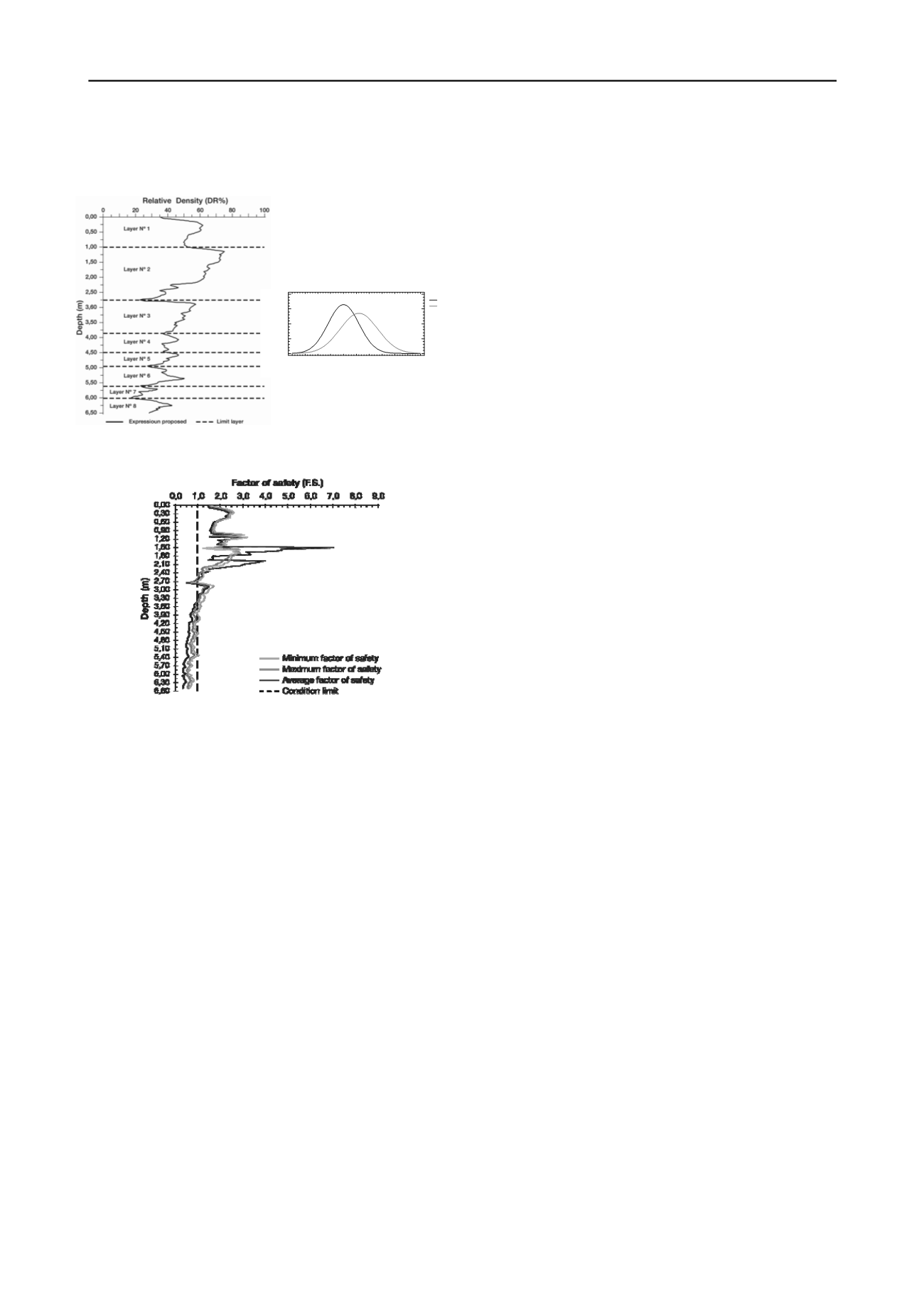
522
Proceedings of the 18
th
International Conference on Soil Mechanics and Geotechnical Engineering, Paris 2013
CRR/CSR is lower than unity. It is widely accepted that
estimating the cyclic resistance ratio (CRR) can be estimated on
the basis of dynamic and static penetration tests (Robertson and
Wride 1998, Boulanger 2004 and Idriss, etc.).
a)
b)
Figure 5. a) The breakdown into layers and density index (ID%). b) The
distribution of Density Index (ID%). Test No. 1. Tailings dam No. 1.
Figure 6. Example of the factor of safety (F.S) profile. Test No. 1.
Tailings dam No. 1.
3 CONCLUSIONS
To predict the behaviour of mine tailings dams in view to
managing the risks inherent to them, it appears necessary to
carry out a probabilistic approach However, in practice
implementing this type of approach is limited by the difficulty
of managing the data to be used in reliability calculations for the
limit conditions concerned. This article proposed a method for
estimating in situ the density index (ID%) and the effective
friction angle (
’) and its variability, making it possible to carry
out a probabilistic study of these structures. A single model was
proposed for all the mine tailings dams in Chile, in view to
linking a probability law to ID% and the
’.
A method was proposed that takes into account the spatial
variability of data for performing a reliability calculation of
liquefaction potential, which is the main cause for the failure of
this type of structure. On the basis of the results obtained, we
showed that the method proposed for estimating liquefaction
potential permits evaluating the probability of triggering this
phenomenon. Estimating the reliability of a dam in relation to
the limit states of static and dynamic stability demonstrates the
advantages and applicability of the approach, by using the
variability of the geotechnical characteristics of mine tailings
and resistance to penetration (qd
N1
) in particular.
4 ACKNOWLEDGEMENTS
Fundings for the work described in this paper was provided by
the research department of the Pontifical Catholic University of
Valparaiso Chile. This article was developed with the important
collaboration from the Professor, Mr Pierre Foray, Laboratory
3S-R, Institut National Polytechnique de Grenoble, France.
2
REFERENCES
Benz M.A. 2009.
Mesures dynamiques lors du battage du pénétromètre
Panda 2
. Ph. D. Thesis, Blaise Pascal-Clermont II Univ, France.
Bolton M. 1986. The strength and dilatancy of sands.
Géotechnique
36
(1), 65-78.
Boulanger R. and Idriss I.M. 2004.
State normalization of penetration
resistance and the effect of overburden stress on liquefaction
resistance.
Proceedings 11
th
SDEE and 3
rd
ICEGE, Berkeley, CA,
484- 491.
Chaigneau L. Bacconnet C. and Gourvès R. 2000.
Penetration test
coupled with geotechnical classification for compacting control
. An
International Conference on Geotechnical & Geological
Engineering, GeoEng2000, Melbourne, Australia
Díaz E. and Rodríguez-Roa F. 2007. Ensayos in-situ en Arenas. VI
Chilean Congress of Geotechnical Engineering. Chilean Society of
Geotechnics. Univeridad Católica de Santiago. Chile, November,
28-30.
Scale
Global
Local
Index Density (ID%)
Density Function
0 10 20 30 40 50 60 70 80 90 100
0
0,01
0,02
0,03
0,04
Dobry R. and Alvarez L. 1967. Seismic failures in chilean tailings
dams.
J. Soil Mech. & Foundation Eng. ASCE
, SM6 (93), 237-260.
ICOLD. 2001.
Tailings dams. Risk of dangerous occurrences. Lessons
learnt from practical experiences.
Bulletin Nº 121. UNEP, DTIE
and ICOLD, Paris.
GEER (Geo-Engineering Extreme Events Reconnaissance Association)
2010. Dams, levees, and mine tailings dams. Turning disaster in
knowledge: geo-engineering reconnaissance of the 2010 Maule,
Chile Earthquake.
J. Bray and D.Frost, Eds
., 204-226.
Gourvès R. Oudjehane F. and Zhou S. 1997. The in situ characterization
of the mechanical properties of granular media with the help of
penetrometer.
Proceedings of 3
rd
International Conference on
Micromechanics of Granular Media, Powders and Grains
, Duram,
USA, 57-60.
Lepetit, L. 2002.
Etude d’une méthode de diagnostic de digues avec
prise en compte du risque de liquéfaction.
Thesis, Blaise Pascal-
Clermont II Univ, France
Moss R.E. Seed R.B. Kayen R.E. Stewart J.P. and Der Kiureghian A
2006.
CPT-Based probabilistic assessment of seismic soil
liquefaction initiation.
PEER Report 2005/15.
Rahim A. Prasad SN, and George K.P. 2004. Dynamic cone penetration
resistance of soils-theory and evaluation.
Proceedings of the Geo-
Trans 2004 Conference
, Los Angeles, California.
Robertson P.K. and Wride C.E. 1998. Evaluating Cyclic Liquefaction
Potential Using The Cone Penetration Test.
Canadian Geotechnical
Journal
, 35 (3). 442-459.
Salgado R. Boulanger R. and Mitchell J. 1997. Lateral effects on CPT
liquefaction resistance correlations.
J. of Geotechnical and
Geoenvironmental Engineering, ASCE
, 123 (8). 726-735.
Seed H.B. and Idriss I.M. 1981.
Evaluation of liquefaction potential of
sand deposits based on observations and performance in previous
earthquakes.
In Situ Testing to Evaluate Liquefaction
Susceptibility, ASCE Annual Convention, St. Louis.
Skempton S.M. 1986. Standard penetration test procedures and the
effects in sands of overburden pressure, relative density, particle
size, aging and overconsolidation.
Geotechnique
36 (3). 425-447.
Tatsuoka F. Zhou S. Sato T. and Shibuya S. 1990.
Evaluation method of
liquefaction potencial and its application.
Report on Seismic
Hazards on the Ground in Urban Areas. Tokyo. 75-109.
Troncoso J. 1986. Envejecimiento y estabilidad sísmica de un depósito
de residuos minerales en condición de abandono. ISSN-0716-0348.
(22), 147-158.
Verdugo R. 1997. Compactación de Relaves. IV Chilean Congress of
Geotechnical Engineering. Chilean Society of Geotechnics,
Santiago. Universidad Federico Santa María. Chile. October, 29-4.
Villavicencio G. 2009.
Méthodologie pour evaluer la stabilite des
barrages de résidus miniers.
Ph. D. Thesis, Blaise Pascal-Clermont
II Univ, France.
Villavicencio G. Bacconnet C. Breul P. Boissier D. and Espinace R.
2011. Estimation of the Variability of Tailings Dams Properties in
Order to Perform Probabilistic Assessment.
Geotechnical and
Geological Engineering
. 29 (6). 1073-1084.


